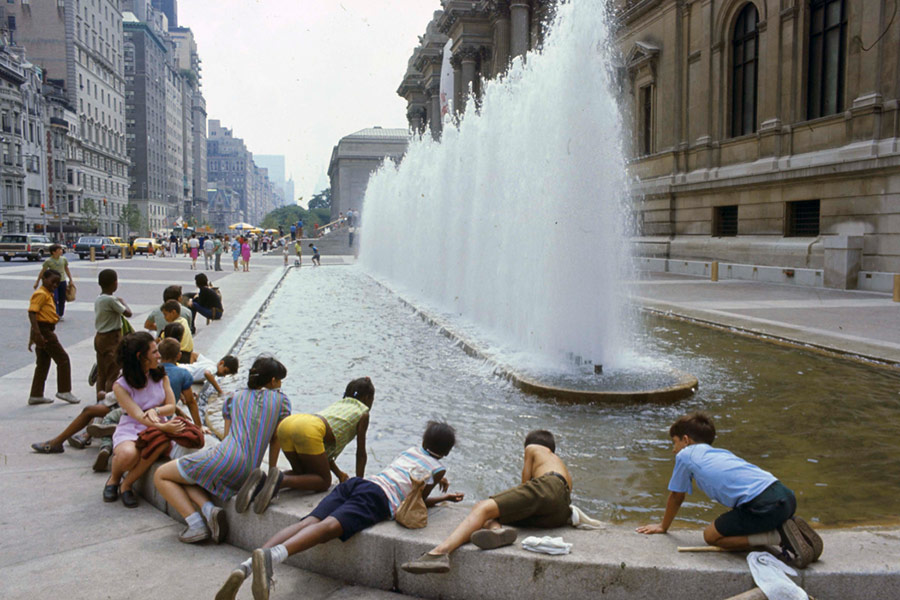
In February of the year 2012, when the Metropolitan Museum of Art first announced the redesign of the City-owned Fifth Avenue-fronted plaza along its grand McKim, Mead & White Beaux-Arts facade, there was little opposition from preservationists. A $65 million underwriting pledge from museum trustee, David H. Koch, catalyzed the selected competitive plan from Philadelphia-based OLIN. It proceeded through the approval process with relative dispatch.
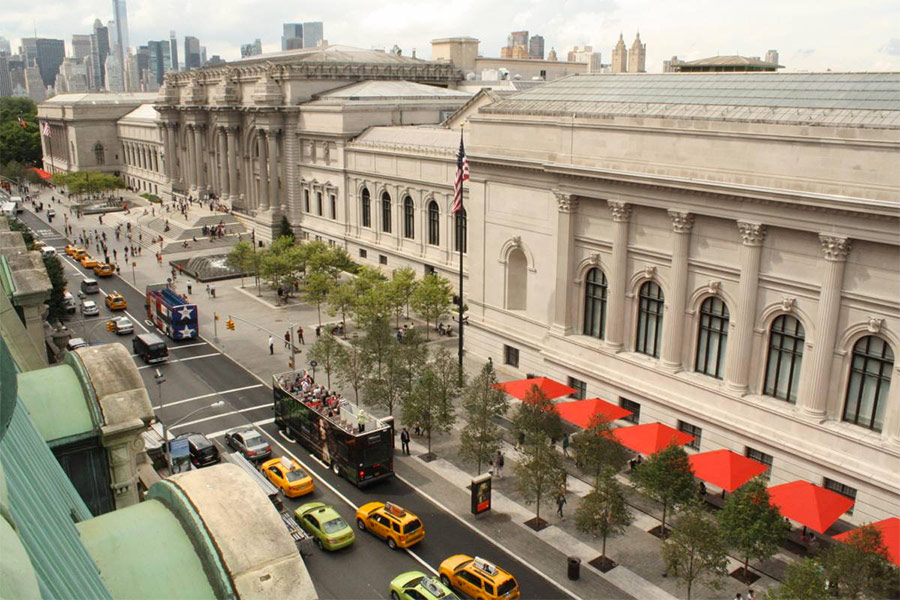
Curiously when first unveiling the OLIN proposal, the Museum stated explicitly that despite Mr. Koch’s enlivening donation, the resulting plaza renovation would in fact not bear his name. Anonymity on top of benevolence spells charitable grace at its peak.
Pretty much the sole impediment to this civic embellishment—so welcome against existing conditions of cracked sidewalks, failing hydraulics, deformed and dying trees, a long-neglected fountain, and meager old-fashioned exterior lighting—were the cries of what seemed at the time just another hopeless band of Luddites reflexively resistant to change of any sort. They included tree huggers acting as they did as if the jejune water-choked grove then there consisted of old growth sequoias instead of pooped out sycamores.
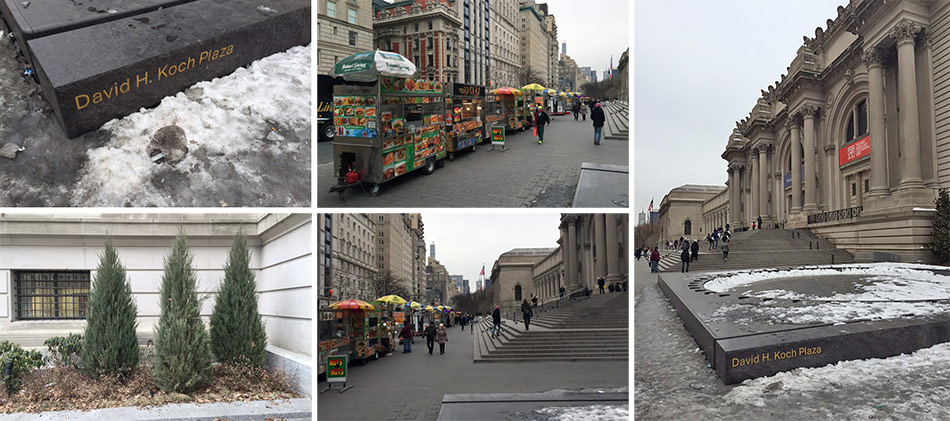
More recent opposition came from those protesting the donor himself as they heatedly dissed his many such civic good works in the realms of culture, medicine and education as little more than candy-coated camouflage of his role as Citizen’s United election-stealing kingpin. In this way, focus shifted away from plaza’s design and impact on form and function to the symbolism of support, especially when in the end the David H. Koch name was indeed carved with gilded precision on the new fountain basins heralding all those approaching whether from north or south.
More considered objection first came, however, from the testimony of the New York/Tri-State Chapter of DOCOMOMO given before the aesthetic overseers at the Landmarks Preservation Commission. They argued for the integrity of the plaza solution that was part of the original overall 1970 Kevin Roche Met master plan, which even forty years later is still generally in guiding force:
Roche’s declared design intention was to create an open urban plaza that defers to and displays the monumental Beaux-Arts façade of the museum. He wanted to distinguish the urban face …on Fifth Avenue from the park portions of the other three sides… (The Chapter) is hopeful that any modifications to the present plaza, to the extent that they are necessary, conform to the underlying principles of the Kevin Roche design-preserving an open urban plaza with unimpeded access to (his ingeniously three –sided) entrance stairway and unobstructed visibility of the stairs, adjacent facades and ground level entrances.
And with the results now plain, how right they were. With the exception of a masterwork of exterior nighttime illumination by Hervé Descottes and his L’Observatoire International that subtly responds to the architecture’s classical hierarchies and the replenishment of the subsoil, it is only now that the relative dignity of this earlier renovation is fully evident. Restoration of the restoration was a worthy option after all. Apologies are due them.
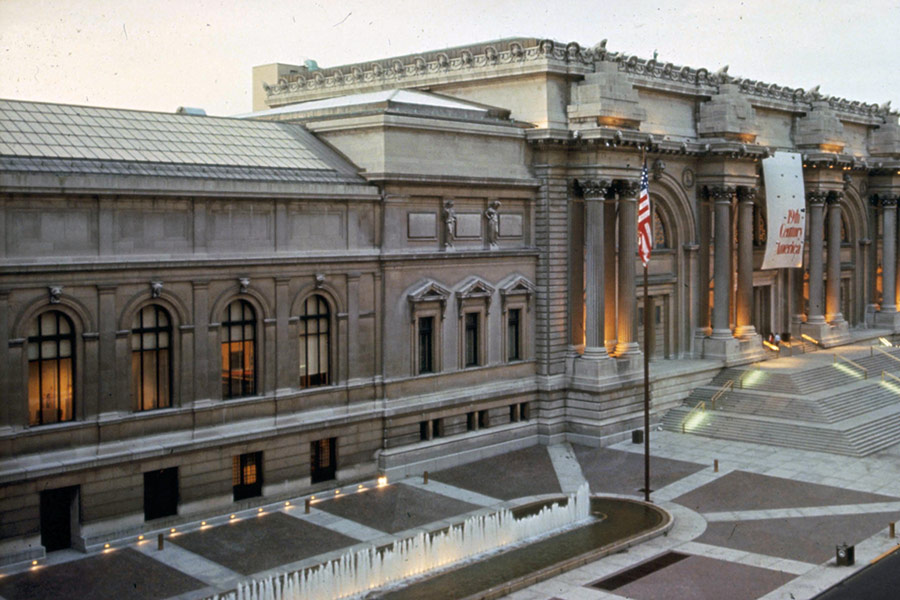
Despite some working drawings from McKim, Mead, & White in which the option of flower and shrub beds appeared alongside the façade elevation, their final intent was clear with the dignified built encounter of limestone and pavers accentuated further by the pedestrian-scaled Roman grills that inform urban places of majesty and safe-keeping. OLIN’s decision to place such beds there seems a pallid suburbanization vying to extend the park setting instead of contrasting it. Imagine flowers alongside the Pantheon or its Renaissance-descended Palazzo Farnese?
Meanwhile, the new fountains, while retaining a classical symmetry, end up compromising the pomp and circumstance of the Roche-thrusting and much expanded grand stairs with a tight perplexing proximity. The visitor today cannot help but wonder if it is some disguised stab at crowd control. And while their new placement was meant in part to make more legible the secondary street-grade entrance at 81st Street, the trade-off is untested and dubious; who can resist mounting those stairs? This is a classical threshold at its iconic best. The waterworks vary in height and rhythm in a mannered echo of WET Design’s signature creations yet at low height the sprouts seem more than a tinkle.
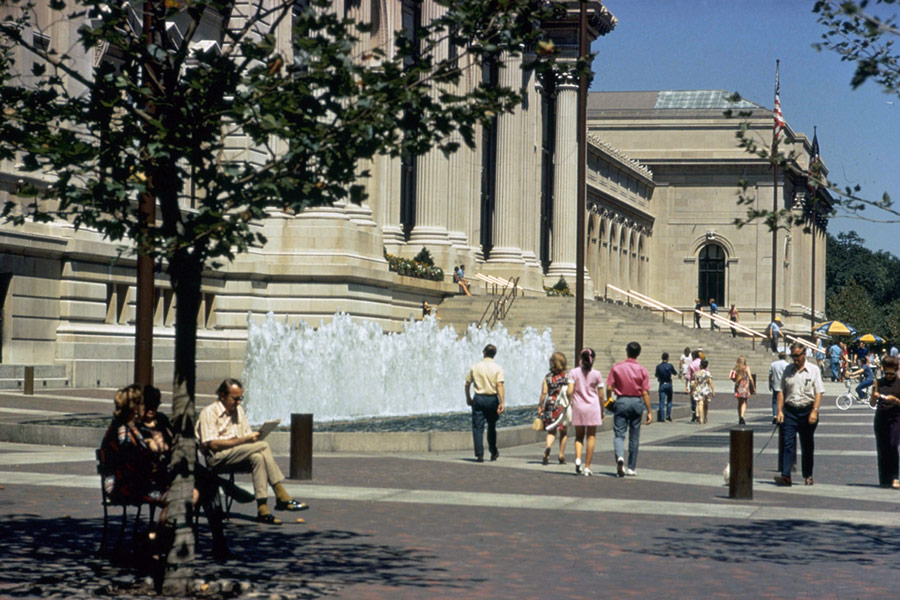
The previous fountains recalled the classical rigor that informed so much of high Modernism. This was never meant as a playful place. Instead it was always meant for unencumbered dignity; all who enter should arrive as big shots knowing that they each held a key to this great repository of beauty and truth.
Likewise the addition of dozens of trees even as now young and leafless obscures the architecture. What about in 20 years? It is hard to object to more trees in this warned up day and age but here is one place where the sum is less than the design parts.
Finally and through no fault of either client or landscape architect there is a the all too frequent New York curse of visual pollution as arises in public places, where governing statures collide and, in turn, destroy the clarity of the guiding design blueprint. Here at the Met plaza, it is the curbside licensed food vendors.
Ironically the spot-on instinct on the Museum’s part to include in its initial plan outdoor kiosks for such inevitable trade was denied by the oversight Landmarks and Public Design Commissions in convenient disregard for the ultimate reality of the streets.
With the present redesign, Mr. Koch might well wish that for now at least his name not be its site label after all. He seems shortchanged as much as those he generously aims to benefit.











